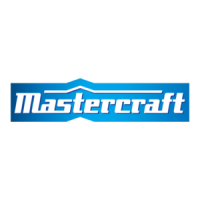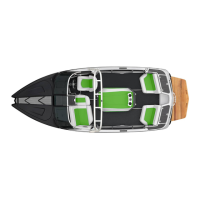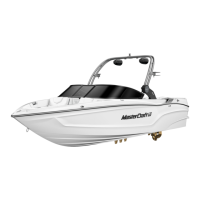(opposite the wind) and turn OFF the engine prior to reaching them. Propellers and
engine exhaust are only part of the potential problem for someone in the water. Be
aware that propellers may continue to turn for a period of time after the engine is
shut OFF, and the edges are often sharp enough to easily cut skin or break bones.
• Ski and wakeboard only in acceptable areas. Avoid restricted areas.
• The above mandates are not all-inclusive. It is the boater’s responsibility to operate
the boat in a safe fashion and become familiar with any and all rules and regula-
tions governing boat operation.
Do not tow more than two (2) persons at one time on a tow tower. The tow
tower approved for use on your boat should
be used only for water skis, wakeboards or
recreational towables, and not for parasailing,
kite flying or towing other boats. Do not add
any attachments that are not approved for use
on your MasterCraft boat. Do not climb on, sit
on, stand on, jump o of or dive o of the tower.
Never allow passengers to sit behind the tow rope attachment point. Never al-
low loose tow rope ends to dangle. Always be certain that all bolts are in place
and tight before and during use. When the tower is up, watch for low obstacles
such as tree limbs, bridges or power lines.
Warning Plates and Labels
Read and note ALL warning plates and labels from bow to stern, including those
that are installed inside the engine compartment, lockers and under seating. YOU MUST
READ AND ADHERE TO ALL CAUTIONS AND WARNINGS IN AND ON YOUR BOAT!
Operator’s Responsibilities
• Ensure the boat is in top operating condition and there are no hazards that impede
your moving about the boat.
• Ensure the bilge is clean prior to starting.
• File a oat plan, as described below, with a relative or friend.
• Have a complete knowledge of the operation and handling characteristics of your
boat.
• Ensure that the boat is not loaded above the maximum capacity and that the load
is properly distributed.
• Have familiarity with your starting location and your goal, and the waterways be-
tween.
• Maintain a safe speed at all times to avoid collisions.
• Keep an eye out for changing weather conditions and respond accordingly.
• Know and practice the navigational rules. Know and obey all federal and state regu-
lations and operate the boat properly around all waterway markers.
• Maintain a clear, unobstructed view at all times, especially forward. Scan the water
and avoid tunnel vision. Many boating collisions are caused by inattention.
Float Plan
A “oat plan” is a written record indicating the planned destination and approxi-
mate length of time for the outing. Sample forms are available at the Coast Guard’s
website. One should be completed and left with a relative or friend prior to each trip. In
case of an emergency or failure to return within a reasonable period of time, pertinent
information will be available to assist local marine police or the Coast Guard in determin-
ing whether a search should be performed. Be sure to notify the oat plan holder upon
return.
Nautical Charts
Nautical charts are especially important to boaters planning trips, particularly on
2013 MasterCraft Owners Manual • Safety Knowledge • Page 1-15

